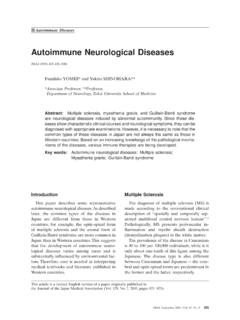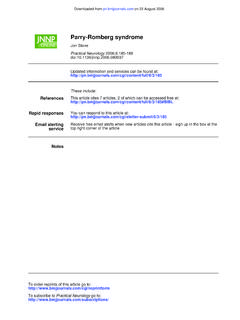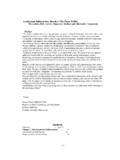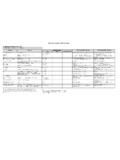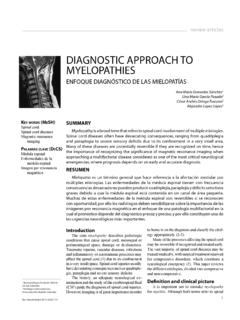Transcription of EFNS guidelines for the use of intravenous …
1 EFNS TASK FORCE/CME ARTICLEEFNS guidelines for the use of intravenous immunoglobulin in treatmentof neurological diseasesEFNS task force on the use of intravenous immunoglobulin in treatment of neurologicaldiseasesMembers of the Task Force: I. Elovaaraa, S. Apostolskib, P. van Doornc, N. E. Gilhusd,A. Hietaharjue, J. Honkaniemif, I. N. van Schaikg, N. Scoldingh, P. Soelberg S renseniandB. UddjaDepartment of Neurology and Rehabilitation, Tampere University Hospital and Medical School, University of Tampere, Tampere, Finland;bInstitute of Neurology, School of Medicine, University of Belgrade, Belgrade, Serbia;cDepartment of Neurology, Erasmus Medical Centre,Rotterdam, The Netherlands;dDepartment of Neurology, Haukeland University Hospital, Bergen, Norway;eDepartment of Neurology andRehabilitation, Tampere University Hospital, Tampere, Finland;fDepartment of Neurology, Vaasa Central Hospital, Vaasa, Finland;gDepartment of Neurology, Academic Medical Center, University of Amsterdam, Amsterdam, The Netherlands;hUniversity of BristolInstitute Of Clinical Neuroscience, Frenchary Hospital UK Bristol, UK;iDepartment of Neurology, National University Hospital,Rigshospitalet, Copenhagen, Denmark.
2 AndjDepartment of Neurology and Rehabilitation, Tampere University Hospital and Medical School,University of Tampere, Tampere, FinlandKeywords:acute disseminatedencephalomyelitis, Balo sconcentric sclerosis, child-hood refractory epilepsy,chronic inflammatorydemyelinating poly-radiculoneuropathy, der-matomyositis, Guillain-Barre syndrome, intrave-nous immunoglobulin ,multifocal motor neurop-athy, multiple sclerosis,myastenia gravis, neuro-myelitis optica, Rasmus-sen s encephalitis, stiff-person syndrome andpost-polio syndromeReceived 16 March 2008 Accepted 25 June 2008 Despite high-dose intravenous immunoglobulin (IVIG) is widely used in treatment ofa number of immune-mediated neurological diseases, the consensus on its optimal useis insufficient. To define the evidence-based optimal use of IVIG in neurology, therecent papers of high relevance were reviewed and consensus recommendations aregiven according to EFNS guidance regulations.
3 The efficacy of IVIG has been provenin Guillain-Barre syndrome (level A), chronic inflammatory demyelinating polyradi-culoneuropathy (level A), multifocal mononeuropathy (level A), acute exacerbationsof myasthenia gravis (MG) and short-term treatment of severe MG (level A recom-mendation), and some paraneoplastic neuropathies (level B). IVIG is recommended asa second-line treatment in combination with prednisone in dermatomyositis (level B)and treatment option in polymyositis (level C). IVIG should be considered as a secondor third-line therapy in relapsing remitting multiple sclerosis, if conventionalimmunomodulatory therapies are not tolerated (level B), and in relapses duringpregnancy or post-partum period (good clinical practice point). IVIG seems to have afavourable effect also in paraneoplastic neurological diseases (level A), stiff-personsyndrome (level A), some acute-demyelinating diseases and childhood refractoryepilepsy (good practice point).
4 BackgroundIntravenous immunoglobulin (IVIG) has been success-fully used to treat a number of immune-mediateddiseases of the central and peripheral nervous underlying mechanisms of action of IVIG have not been fully explained, it is known that IVIG caninterfere with the immune system at several levels. Theeffect of IVIG in one of particular diseases may not beattributed to only one of its mechanisms of action,because the pathophysiology of these diseases is com-plex. IVIG has been used as a first-line therapy inGuillain-Barre syndrome (GBS), chronic inflammatorydemyelinating polyradiculoneuropathy (CIDP),multifocal motor neuropathy (MMN) and dermato-myositis (DM). It may be used also in diseases ofCorrespondence: Prof. Irina Elovaara, Department of Neurology andRehabilitation, Tampere University Hospital and Medical School,University of Tampere, Tampere, Finland (tel.: 358 3 311 66692;fax: 358 3 311 64351; e-mail: is a Continuing Medical Education article, and can be found withcorresponding questions on the internet at Certificates for correctly answering thequestions will be issued by the EFNS.)
5 2008 The Author(s)Journal compilation 2008 EFNS893 EuropeanJournalofNeurology2008,15:893 908 , multiple sclerosis (MS) and in somerare neurological disorders of adults and childrenincluding Rasmussen s encephalitis (RE), stiff-personsyndrome (SPS) and post-polio syndrome (PPS). In thispaper we have reviewed the available literature on theuse of IVIG in treatment of neurological diseases andare offering evidence-based recommendations for its usein these and methodsSearch strategyThe task force systematically searched Ovid Medline andseveral other sources to a set of predefined key final search was performed in December 2007. Re-cent papers of high relevance were reviewed. Consensuswas reached by discussions during a task force was classified as class I IV and recommenda-tions as level A C according to the current EFNS guidelines [1]. When only class IV evidence was availablethe task force has offered advice as good practice of action of IVIG in neurologicaldiseasesDespite over 25 years usage in autoimmunity, howconcentrated non-host immunoglobulins, deliveredintravenously, produce their clinical effect remains un-known.
6 Of manypotentialmechanisms of action [2],whether one (unlikely), all (likewise) or several togetherare important remains obscure. Probably, different ef-fects are relevant in different disorders. We here con-sider the range of possible actions of IVIG, stressingeffects that appear especially pertinent in specific neu-rological possibility that IVIG works through non-im-mune mechanisms [3] binding and removingmicrobial toxins, or targeting their surface antigens isperhaps less relevant in neurology. However, directactions on oligodendrocyte progenitors have beenpostulated to explain an effect in promoting experi-mental remyelination [4,5], although alternative mech-anisms are possible [6 9].More direct immune-modulating effects are generallyconsidered more neurologically relevant. T-cell prolifer-ation is reduced by IVIG [10], various pro-inflammatorycytokines are suppressed, including interleukin-1,tumour necrosis factor-aandc-interferon, and lym-phocyte and monocyte apoptosis is induced [11].
7 Endogenous immunoglobulin production and B-celldifferentiation are suppressed, and IgG catabolism isaccelerated by IVIG [3]. Therapeutic immunoglobulinsexert Fc region-mediated inhibition of antibodyproduction; they also modulate anti-idiotypic networksvital to immune addition, IVIG contains anti-idiotypic antibodiesthat bind to F(ab) to neutralize autoantibodies amechanism involved in GM1-related neuropathy andperhaps GBS [12,13]. Finally considering cytopathicimmune effectors, IVIG interferes with the complementsystem: the beneficial effects of IVIG are associatedwith disappearance of complement in the muscles [14],involved suppression of macrophage function throughinduction of increasedUFccRII-B expression, reducingphagocytic syndromeThe proposed autoimmune aetiology led to the intro-duction of immunotherapy. Before its introduction,10% of patients died and 20% were left seriously dis-abled [15].
8 Plasma exchange (PE) was introduced as apossible treatment in 1978 and was shown to offer sig-nificant benefit by a randomized trial published in 1985[16,17]. It became the gold standard against which othertreatments were measured [18]. intravenous immunoglobulin was introduced forGBS in 1988 [19]. In 1992, the first randomized trialcomparing IVIG and PE showed similar effects fromeach treatment [20]. In five trials with altogether 582participants, the improvement on the disability gradescale with IVIG was very similar to that with PE,WMD (95% CI ) [20 24]. This effec-tiveness of IVIG has been shown in GBS patients un-able to walk unaided (GBS disability score 3) whowere started on IVIG within the first 2 weeks afteronset of weakness. Results from PE studies indicatethat PE is also effective when applied in patients lessseverely affected [25] and in patients who are treatedwithin the first 4 weeks from onset [17].
9 This has notbeen investigated in studies on IVIG treatment . Al-though PE was more frequently discontinued, there wasalso no significant difference between IVIG and PE forother outcome measures [23]. One trial compared PEalone with PE followed by IVIG: the 128 patients whoreceived both treatments did not had significant extrabenefit after 4 weeks of treatment compared with the121 patients who received PE alone [22].In children, who may have a better prognosis thanadults, limited evidence from three open trials suggeststhat IVIG hastens recovery compared with supportivecare alone [26 28], which is supported by a good qualityobservational study [29].A recent trial reported possible minor short-termbenefit when high-dose intravenous methylprednisolonewas combined with IVIG [30]. The significance of thisbenefit has been debated [31].894I. Elovaaraet al. 2008 The Author(s)Journal compilation 2008 EFNSE uropeanJournalofNeurology15, 893 908 The comparisons of IVIG and PE showed no differ-ence in the long-term outcome.
10 IVIG nor PE or anyother treatment does significantly reduce mortality,which ranged from 5% to 15%, in hospital and popu-lation-based studies [32].Only limited information is available concerning thedosage of IVIG. The usual IVIG regimen is g/kg/day for 5 days. In a French trial, 3 days of g/kgdaily was slightly, but not significantly, less effectivethan 6 days of g/kg daily [25].In retrospective studies, patients with antibodies toganglioside GM1 or GM1b treated with IVIG recov-ered faster than those treated with PE [33 35]. There isno evidence that it is better to administrate IVIG (2 g/kg) in 2 or in 5 days. There is some indication thatadministration in 2 days may lead to a greater pro-portion of patients with a relapse [28].Information is also lacking about how to treat pa-tients who worsen or fail to improve after being treatedwith IVIG or PE. It is common practice to re-treatpatients who improve or stabilize and then relapse withIVIG (2 g/kg in 2 5 days) or PE again.
